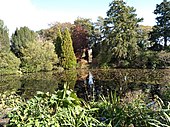This is an old revision of this page, as edited by Dl2000 (talk | contribs) at 03:39, 8 February 2021 (en-IE). The present address (URL) is a permanent link to this revision, which may differ significantly from the current revision.
Revision as of 03:39, 8 February 2021 by Dl2000 (talk | contribs) (en-IE)(diff) ← Previous revision | Latest revision (diff) | Newer revision → (diff)Country House in County Carlow, Ireland
| Altamont House | |
|---|---|
 | |
| General information | |
| Type | Country House |
| Location | Tullow, County Carlow, Ireland |
| Construction started | 1740 |
| Completed | 1780 |
| Owner | Government of Ireland |
| Website | |
| www | |
Altamont House is a historic building best known for its ornamental gardens in County Carlow. The Robinsonian-style gardens are often referred to as "the jewel in Ireland's gardening crown".
History
The early origins of the house are unclear, with some claiming that the building was first built as a convent, perhaps dating as far back as the 16th century. The central section of the house dates from the 18th century and the sections that face the east remain unchanged, were built by the St George family. Most of these changes to the house were to reverse it to face a newly built road. During the 1780s, Benjamin Burton Doyle the High Sheriff of Carlow lived at the house. In the 1840s the Dawson Borrer family refurbished and altered the house and gardens, adding the lake that was dug as relief work for the local population during the Irish famine.
Feilding Lecky Watson bought Altamont in 1923, and proceeded to extend and expand the gardens. Watson's interest was primarily in rhododendrons, planting seedlings from around the world and exchanging specimens with Sir Frederick Moore of the National Botanic Gardens. Following Watson's death in 1943, his daughter, Corona North continued her father's horticultural work.
Gardens
The garden sits on the banks of River Slaney which includes an ice age glen, bog garden and arboretum, with view of the Blackstairs Mountains, Wicklow Mountains and Mount Leinster. Some of the oaks are believed to be over 500 years old, and the varying environments provide habitats for diverse set of wildlife. The garden is home to a variety of rare azaleas, rhododendrons, magnolias, as well as wild bluebells and snowdrops. The gardens also feature a Wellingtonia, the Sequoiadendron giganteum or Giant Redwood, which was planted to commemorate the Battle of Waterloo.
A trust was set up in the early 1990s to preserve the estate of 100 acres. Following the death of Corona North, ownership of the house and gardens was transferred to the Irish State, and is operated by the Office of Public Works.
Gallery
See also
References
- "Altamont Gardens". Houses, Castles and Gardens of Ireland. Archived from the original on 20 July 2015. Retrieved 2 May 2015.
- ^ "Altamont Garden". Ask About Ireland. Retrieved 2 May 2015.
- ^ "A Brief History of Altamont House and Garden". Altamont Garden. Archived from the original on 4 February 2015. Retrieved 2 May 2015.
- ^ O'Toole, Jimmy (1993). The Carlow Gentry. Carlow: The Leinster Leader. ISBN 0952254409.
- ^ "Altamont, County Carlow". Ireland's Eye. Retrieved 2 May 2015.
- Taylor, Patrick (2008). Gardens of Britain and Ireland. London: Dorling Kindersley Ltd. p. 218. ISBN 9781405336253.
- Powers, Jane (24 May 1997). "A Passion For Rhododendrons". The Irish Times. Retrieved 2 May 2015.
- "Altamont House & Gardens". Do Chara. Retrieved 2 May 2015.
- "Corona North 1922 - 1999". Altamont Gardens. Archived from the original on 4 February 2015. Retrieved 2 May 2015.
- Fallon, Fionnuala (18 January 2014). "A sprinkling of spring". The Irish Times. Retrieved 2 May 2015.
- "A Gift to the Nation". The Nationalist. 21 January 2014. Retrieved 2 May 2015.
- "Keys of Altamont are handed over to State". Carlow People. 28 January 2014. Retrieved 2 May 2015.



